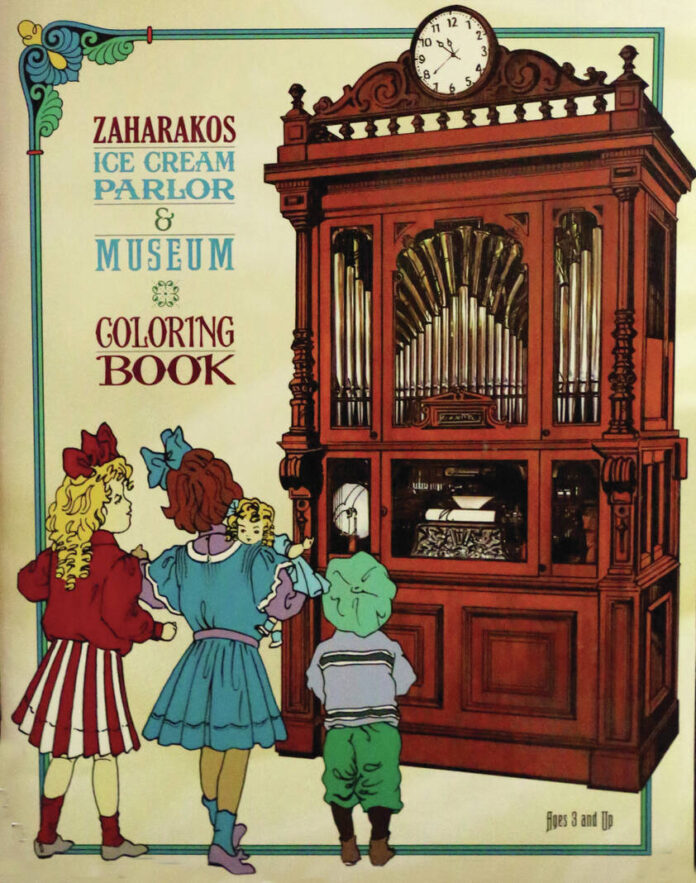
The first project Debra Seward Slone did for Zaharakos was the creation of this coloring book. Monday, June 13, 2022
Photos by Carla Clark | For The Republic
When Debra Seward Slone picks out her wardrobe for a special occasion, two factors are likely to come into play.
One, the event will be historical in nature — as history is the Hope native’s passion. And two, her clothing will be vintage or antique, the later distinction indicating it’s more than 100 years old.
You may have seen Slone in costume giving tours of the second-floor Crystal Parlor above the 1900 era Zaharakos Ice Cream Parlor and Museum in downtown Columbus, as she did this past weekend for the Bartholomew County Historical Society’s Open Door Tour — Behind the Scenes.
Then again, maybe you caught one of her 2020 programs on women’s suffrage that marked the 100th anniversary of Indiana women receiving the right to vote.
Or perhaps you ran into Slone at a Yellow Trail Museum event in Hope such as Christmas of Yesteryear or Old-Fashioned Independence Day, coming up Friday.
“When you slip on an elegant vintage dress — with petticoat, tuck seams, layers of lace — the hair goes up, the hat goes on with the hat pins to hold it into place,” said Slone, who retired at the end of last year after a 46-year career as a graphic designer. “Add jewelry, gloves and a parasol. Your posture becomes straight, your head held higher and you’re transformed to a slower, simpler time.”
There is no need for Slone to rent an attention-getting vintage outfit for a historical event. Her two-story, restored 1869 farmhouse north of Hope is filled with vast selections of vintage clothing and accessories, purchased during visits to auctions, antique shows and antique shops.
“I’ve always loved fashion,” said Slone, 66. “Fashion has the ability to link us to our past, a nostalgic connection, and it transports not only the wearer but the people who see you.”
From the reactions on people’s faces, “you can tell it takes them back,” she said.
Slone’s favorite period is the early 1900s.
“I love the fashion,” she said of the era when the Gibson Girl arrived in pen-and-ink illustrations by artist Charles Dana Gibson.
Gibson’s drawings personified a feminine ideal of physical attractiveness, arriving at a time when the “new woman” emerged on the American scene as females pursued higher education, romance, marriage, physical well-being and individuality, Slone said.
Known as the Progressive Era, women in the early 1900s were fighting for the right to vote, embracing social change and “weren’t so confined,” Slone said.
Clothing was becoming more comfortable to wear as women were gaining more independence and enjoying more luxuries.
Skip ahead a few decades and you’ll find clothing in Slone’s collection from a different generation, including a red polka-dot dress she bought about 12 years ago at a Madison antique shop.
When Slone came across the dress, a paper note pinned to it provided historical context: “This is the dress Mom made for me when Benny returned home from World War II.”
Sensing a connection to the dress, “I tried it on and it fit me perfectly,” Slone said.
But however perfect a vintage dress may appear, a hat becomes “the grand finale of an outfit,” she said.
Fortunately, there is no shortage of headwear within reach for Slone to choose from.
Slone has about 200 antique and vintage hats stored in 45 hat boxes in an upstairs sewing and work room. They range from the late 1800s to the 1950s. Some hat boxes from the 1940s and 1950s are from Indianapolis department stores such as L.S. Ayers and Block’s with illustrations printed on the outside.
Interest in vintage attire has mirrored people’s fascination with historical television shows and movies such as:
- “Downton Abbey,” the British television drama series from 2010 to 2015 on PBS and feature-length movies in 2019 and this year, depicting British aristocratic life from 1912 to 1926.
- The two-season “Bridgerton” romantic series that debuted on Netflix in 2020, depicting the Regengy Period in London, England between 1813 and 1827.
One large, wide hat in Slone’s collection is from 1912, during the “Titanic” era. The 1997 movie starring Kate Winslet and Leonardo DiCaprio achieved critical and commercial success.
“Popular culture connects to vintage fashion,” Slone said.
A favorite model of Morgan County artist Fred Kreiter, several of his paintings of Slone in vintage clothing are displayed on the walls of her home. They include a 24-inch -by- 36-inch work depicting Slone in the dress she wore during the Zaharakos grand re-opening.
Slone’s connection to the dining tourism attraction at 329 Washington St. began when owner Tony Moravec hired the graphic artist to create a 36-page coloring book for its opening event.
“I really wanted to be a part of it,” Slone said of the restoration, with her focus primarily on design, decoration and special events.
Slone subsequently took on one Zaharakos assignment after another, a relationship that has continued into her retirement.
“Zaharakos became a labor of love,” Slone said. “I would try to do things that were fun for me after so many years of deadlines.”
Moravec had gotten to know Slone when she was hired to do graphic design work on marketing materials for another of his Columbus companies, Applied Laboratories.
As they started on the Zaharakos restoration, Slone helped Moravec secure items that would cement the authenticity of the original period.
“We went to some antique auctions together and I realized that she was a big antique collector and had a very good eye for furniture,” Moravec said.
So when his attention turned to the building’s second floor, where several members of the Zaharako family lived in the early 1900s but more recently had been used for storage, Moravec told Slone: “You’re better at this antique stuff than I am. I’m going to turn you loose to acquire the items that are needed.”
“I’m a graphic designer, not an interior designer,” Slone said she responded to Moravec, who nevertheless insisted that she decorate the Crystal Parlor.
So Slone picked out curtains, bedroom furnishings and fireplace tiles. She also furnished the kitchen with modern appliances that had an old-time feel.
“She’s responsible for the majority of the polishing and shining of the facility,” Moravec said.
“It’s become part of me, and I love it,” Slone said of Zaharakos, which stands out as an authentic turn-of-the-century building in a city known for its mid-century modern architecture.
Her work with the Zaharakos restoration earned her the 2013 Distinguished Alumnus Award from Ivy Tech Community College in Columbus.
From 2018 until her 2021 retirement, Slone served as Moravec’s executive assistant.
In that capacity, Slone managed special events for Moravec’s companies, including the Celebration on the River event Aug. 13-14, 2021 at his Upland Pump House restaurant, which was part of Columbus Area Bicentennial programming.
Deep local roots
Slone’s interest in history began as a child, listening to stories — most of them about family — shared by her grandparents.
Slone was raised on the family farm along County Road 950 North northwest of Hope, where her great, great grandfather Samuel Seward and his wife Marcia settled in the 1850s.
Without any brothers to help with farm chores, she and her two sisters milked the cows and performed other manual labor on the property.
“I feel a connection to my past,” Slone said.
She later lived in a home located across the field on County Road 1000 North, built by her great grandparents, which she purchased around 1979. She stayed until moving into her current home about three miles away in 1989.
Slone has created pen-and-ink drawings of each of these homes, displayed on the walls of her current residence, purchased from the Major T. Jester family of Shelbyville. They restored the farmhouse and expanded it in 1975 — adding electricity, heat and running water — to create more than 4,000 square feet of living space.
Its exterior is three bricks thick, which helps with insulation given that the home does not have air conditioning. Among special features, its spiral staircase is considered unique for farmhouses in the area.
The restoration included a new kitchen, decorated with an old store counter made of oak and walnut that Slone uses as an island. Nearby are rolls of paper, once used by merchants to wrap grocery purchases, along with string holders and many country antiques collected over several decades.
“It’s very nostalgic and homey,” Slone said of her kitchen. “I can’t get company out if I’m trying to cook.”
She spends a lot of her own time in the upstairs work and sewing room that she further describes as her play room. It contains antiques, her vintage hat collection, vintage clothing and fabric.
A wardrobe closet contains hundreds of neatly stacked feed-sack fabrics from the 1930s to 1950s, an era when people who survived the Depression used the colorful material to make their clothes.
“When I open this wardrobe up, I smile from ear to ear,” Slone said
Her latest collecting passion is ephemera, which is antique vintage paper such as advertising, post cards and valentines.
“I have drawers of that stuff,” she said.
Several examples are displayed on tables, including a Saturday Evening Post from 1910 and a copy of the Ladies’ Home Journal from 1911.
When you don’t have children, “your home becomes your baby,” Slone said.
A former smokehouse connected to the back of her home has become a gathering place for friends and family, where pieces from the original Seward homestead are displayed. It features a huge pot-belly stove.
During a family reunion held there, one young relative blurted out, “Is this a Cracker Barrel?”
Not exactly, but Slone’s home is filled with “two things I’ve loved since I was young, art and history.”
Named by Slone as Cedar Hall, the moniker refers to three old, large Cedar trees in the front yard of her 12-acre property. It also became the name of Slone’s graphic design business.
“I’m ecstatic about being retired. I can start pursuing things I want to get back to doing — art, things I love,” Slone said. “One life is not enough to do everything I want to do.”
Slone has resisted creating and maintaining a bucket list, however.
“It would just stress me out if I didn’t get it done,” she said.




